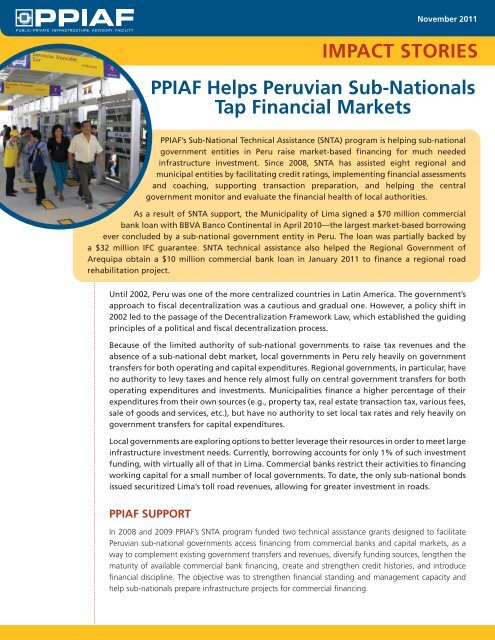PMR cover.psd - ppiaf
PMR cover.psd - ppiaf
PMR cover.psd - ppiaf
You also want an ePaper? Increase the reach of your titles
YUMPU automatically turns print PDFs into web optimized ePapers that Google loves.
PUBLIC-PRIVATE INFRASTRUCTURE ADVISORY FACILITY<br />
November 2011<br />
IMPACT STORIES<br />
PPIAF Helps Peruvian Sub-Nationals<br />
Tap Financial Markets<br />
PPIAF’s Sub-National Technical Assistance (SNTA) program is helping sub-national<br />
government entities in Peru raise market-based fi nancing for much needed<br />
infrastructure investment. Since 2008, SNTA has assisted eight regional and<br />
municipal entities by facilitating credit ratings, implementing fi nancial assessments<br />
and coaching, supporting transaction preparation, and helping the central<br />
government monitor and evaluate the fi nancial health of local authorities.<br />
As a result of SNTA support, the Municipality of Lima signed a $70 million commercial<br />
bank loan with BBVA Banco Continental in April 2010—the largest market-based borrowing<br />
ever concluded by a sub-national government entity in Peru. The loan was partially backed by<br />
a $32 million IFC guarantee. SNTA technical assistance also helped the Regional Government of<br />
Arequipa obtain a $10 million commercial bank loan in January 2011 to fi nance a regional road<br />
rehabilitation project.<br />
Until 2002, Peru was one of the more centralized countries in Latin America. The government’s<br />
approach to fi scal decentralization was a cautious and gradual one. However, a policy shift in<br />
2002 led to the passage of the Decentralization Framework Law, which established the guiding<br />
principles of a political and fi scal decentralization process.<br />
Because of the limited authority of sub-national governments to raise tax revenues and the<br />
absence of a sub-national debt market, local governments in Peru rely heavily on government<br />
transfers for both operating and capital expenditures. Regional governments, in particular, have<br />
no authority to levy taxes and hence rely almost fully on central government transfers for both<br />
operating expenditures and investments. Municipalities fi nance a higher percentage of their<br />
expenditures from their own sources (e.g., property tax, real estate transaction tax, various fees,<br />
sale of goods and services, etc.), but have no authority to set local tax rates and rely heavily on<br />
government transfers for capital expenditures.<br />
Local governments are exploring options to better leverage their resources in order to meet large<br />
infrastructure investment needs. Currently, borrowing accounts for only 1% of such investment<br />
funding, with virtually all of that in Lima. Commercial banks restrict their activities to fi nancing<br />
working capital for a small number of local governments. To date, the only sub-national bonds<br />
issued securitized Lima’s toll road revenues, allowing for greater investment in roads.<br />
PPIAF SUPPORT<br />
In 2008 and 2009 PPIAF’s SNTA program funded two technical assistance grants designed to facilitate<br />
Peruvian sub-national governments access fi nancing from commercial banks and capital markets, as a<br />
way to complement existing government transfers and revenues, diversify funding sources, lengthen the<br />
maturity of available commercial bank fi nancing, create and strengthen credit histories, and introduce<br />
fi nancial discipline. The objective was to strengthen fi nancial standing and management capacity and<br />
help sub-nationals prepare infrastructure projects for commercial fi nancing.

















